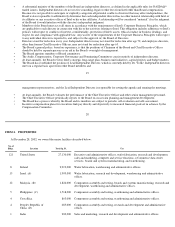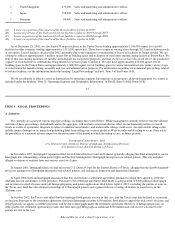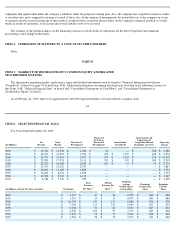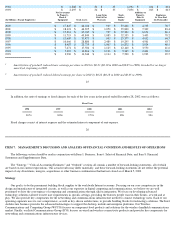Intel 2002 Annual Report Download - page 25
Download and view the complete annual report
Please find page 25 of the 2002 Intel annual report below. You can navigate through the pages in the report by either clicking on the pages listed below, or by using the keyword search tool below to find specific information within the annual report.
the communication and application subsystems for data-enabled cellular phones and portable handheld devices, is a very important part of our
28
WCCG strategy. We expect that the Intel PCA scalable platform will speed application development and allow faster time-to-market for our
customers. For the handheld platform, our current products include Intel® Flash memory, processors based on the Intel® XScale™
microarchitecture, and cellular baseband chipsets. The Intel XScale technology provides the processing capability in Personal Digital Assistants
as well as other types of handheld devices such as Personal Video Players and Smart Displays. We are working toward the convergence of
computing and communications in this market segment by developing technology for mobile handheld clients that combines baseband
communication features with memory and applications processing functionality. In February 2003, we announced our first "wireless-Internet-on-
a-chip" cellular processor, which will integrate these three functions.
Intel Communications Group
Within ICG, our strategy is to be the leading supplier of silicon and integrated networking and communications building blocks for
OEMs. We are developing products that focus on technologies that we believe are essential to build out the Internet: Ethernet connectivity
products, including products designed for wireless applications, optical products and network processing components. Our strategy for Ethernet
connectivity is to expand our product portfolio in the local area network (LAN) market segment and to address the emerging metropolitan area
network (MAN) and networked storage market segments. Within the LAN market segment, we are investing in Gigabit Ethernet and 10-Gigabit
Ethernet technologies, and wireless technologies based on the 802.11 industry standards. In the networked storage market segment, we are
developing products designed to allow storage resources to be added to any location on either of the two most prevalent types of storage
networks: Ethernet or Fibre Channel. For the optical market segment, our strategy is to deliver products based on industry standards, including
Ethernet and data transport standards in the telecommunications industry (SONET/SDH). We are providing 10-Gigabit optical products at
multiple levels of integration with decreased power consumption and increased signal transmission capability. In network processing, we deliver
products that are basic building blocks for modular networking infrastructure. These products include advanced, programmable processors used
to manage and direct data moving across the Internet and corporate networks. The transition to our 90-nanometer manufacturing process is a key
factor in our execution of these strategies. The 90-
nanometer manufacturing process is expected to enable many of our communications products
to feature "mixed-signal" circuitry and high-speed transistors, aimed at creating a new generation of faster, more integrated, less costly
communications chips. As we transition to this new process, we expect to build more of our communications products internally. Currently, a
substantial portion of ICG's manufacturing is performed by third-party foundry manufacturers.
Critical Accounting Estimates
The methods, estimates and judgments we use in applying our accounting policies have a significant impact on the results we report in our
financial statements. Some of our accounting policies require us to make difficult and subjective judgments, often as a result of the need to make
estimates of matters that are inherently uncertain. Our most critical accounting estimates include the assessment of recoverability of goodwill,
which impacts write-offs of goodwill; valuation of non-marketable equity securities, which impacts gains (losses) on equity securities when we
record impairments; valuation of inventory, which impacts gross margin; assessment of recoverability of long-lived assets, which primarily
impacts gross margin when we impair assets or accelerate their depreciation; and recognition and measurement of current and deferred income
tax assets and liabilities, which impacts our tax provision. Below, we discuss these policies further, as well as the estimates and judgments
involved. We also have other policies that we consider to be key accounting policies, such as our policies for revenue recognition, including the
deferral of revenues on sales to distributors; however, these policies do not meet the definition of critical accounting estimates because they do
not generally require us to make estimates or judgments that are difficult or subjective.
Goodwill. In conjunction with the implementation of the new accounting rules for goodwill as of the beginning of 2002, we completed a
goodwill impairment review for the reporting units that have substantially all of our recognized goodwill: ICG and WCCG. According to our
accounting policy, we also performed an annual review during the fourth quarter of 2002, and in both reviews we found no impairment. We will
perform a
29
similar review in the fourth quarter of each year, or more frequently if indicators of potential impairment exist. Our impairment review process is
based on a discounted future cash flow approach that uses our estimates of revenue for the reporting units, driven by assumed market growth
rates and assumed market segment share, and estimated costs as well as appropriate discount rates. These estimates are consistent with the plans
and estimates that we use to manage the underlying businesses. The estimates we used assume that we will gain market segment share in the
future and that the communications businesses will experience a gradual recovery and a return to growth from the current trends. We may incur
charges for impairment of goodwill in the future if the communications sector does not recover as we expect, if we fail to deliver new products
for these groups, if the products fail to gain expected market acceptance, if we fail to achieve our assumed revenue growth rates or assumed
gross margin, or if interest rates increase significantly.
Non
-
Marketable Equity Securities.
At December 28, 2002, the carrying value of our portfolio of strategic investments in non
-
marketable
























